Edited by benjiwuf, January 12 2015 - 1:57 AM.
- Formiculture.com
- Forums
- Gallery
- Members
- Member Map
- Chat
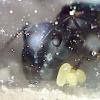
Edited by benjiwuf, January 12 2015 - 1:57 AM.
Well, they continue to amuse / entertain me. They now have chosen to make the liquid feeder their home.

Edited by dean_k, January 12 2015 - 6:05 AM.
it's interesting to see the difference in gaster sizes, my queen's gaster has increased in size to about the same size as her whole nanitic. I may have to try to take a good picture of them side by side sometime.
Formica can be tough to move. In nature, it takes a lot to get them to move their nest. Even when this happens, the workers carry the queen (saw it once).
The workers will remain with the queen. Young workers have a very hard time convincing the queen to move, nanitics are often not big enough to move her.
If they are disturbed enough in the outworld, they will likely move into the nest, but it will take a lot of persuasion.
If you can get all of them into the nest, plug the entrance for 3-5 days. Once they get their scent established, they will prefer to stay in that location.
I suspect the queen doesn't want to go up the ramp. If you have dry sand, you can slowly add it until the entrance is level with the dry sand. If it is dry, they won't be able to dig in it, but you should be able to spook them into the entrance. Once they are in, plug it and remove the sand in the outworld. After 3-5 days to settle in, leave the nest covered and unplug the entrance to let them forage.
"Always do right. This will gratify some people, and astound the rest." -- Samuel Clemens
Sounds very sensible, Crystals. However, I'm still getting him a nest with deeper chambers so the ants have a bit more room.
Do you think low ceiling height may make them uncomfortable? How tall are your ceilings in your Formica nests?
I am thinking forceful relocation is the best for these and they currently have no brood, so it shouldn't be hard to force them to a new location. But I find the current Grotube too small for them, so I am glad that they are not moving into there.
I am not going to lie here. If I had a growth chamber, it would have been my first choice.
I am not going to lie here. If I had a growth chamber, it would have been my first choice.
I don't mind feedback or criticism. But I dropped everything I was supposed to be doing this weekend to get you an alternative style to try, at my expense, and have a nearly complete model in my hands.
Should I stop what I'm doing? I feel like I'm wasting my time, money, and talent fabricating you something new and novel that you have no desire to try, as you seem quite content publicizing your affair with a shot of plaster in a petri dish and hand-carved bricks, like a broken record.
I would advise you and others to not spend any money with my company unless you are interested in being a guinea pig for experiments that carry both the possibility of improving things for antkeepers in new and interesting ways, as well as the possibility of failure.
And if you want a full refund for your GroTube that kills and repels ants, so you can buy more bricks, you may request one.
Edited by drtrmiller, January 12 2015 - 11:38 AM.
I am simply stating my opinion. While I do appreciate what you are doing, the Grotube hasn't quite worked out for me so far. I do not criticize for no reasons. I do not criticize your blue 100 because I know it works and I am not really criticizing your Grotube. I am just saying it looks too small for the current colony and the growth chamber has worked for me, so I favor it naturally.
You do not need to freak out whenever someone criticizes or badmouths your product. I, as a consumer, have a choice and my choices are almost always based on my past experiences instead of biases against individuals.
And based on my own experience, I prefer the growth chamber over the Grotube - currently -.
I apologize if that sounds harsh on you but that is currently how I feel. I will continue to purchase your products which I feel I am going to need but you don't need to come down hard on customers who criticize or sound seemingly against you.
Sounds very sensible, Crystals. However, I'm still getting him a nest with deeper chambers so the ants have a bit more room.
Do you think low ceiling height may make them uncomfortable? How tall are your ceilings in your Formica nests?
As long as the queen can stand, they are fine. They also like to pack themselves together. They like a teeny bit more room than Lasius, but anything that works for larger Lasius room-wise also seems to work for them. Personally, all of my nests have about 1cm deep tunnels and 1.5cm deep chambers since I also put Camponotus in my nests.
But they are one of the more stubborn ants to move. The only species I find harder to move is Lasius.
In the north, they almost never move their nest even if it means certain death.
"Always do right. This will gratify some people, and astound the rest." -- Samuel Clemens
But they are one of the more stubborn ants to move. The only species I find harder to move is Lasius.
Really... I guess I am stuck with stubborn ants.
I remember you telling me that Camponotus spp. are easy to move since they follow heat.
LOL, I feel like any time we talk about Formica I get particularly aggravated at how finicky they are. Hearing stories about their high maintenance ways makes me laugh and feel not so alone in my troubles. I want to give the finger to all the people who told me this was a "beginner" species.
yea, this is not an easy species I'm realizing. I'm beginning to think I will never actively seek them out again ![]() but for my very first queen I'd say it's ok this time.
but for my very first queen I'd say it's ok this time.
Don't be deceived by the picture. This one has twice as much nest volume as the original, and is made of the same material as the foraging area, so the plastic itself will smell the same.
I pre-placed wetted coconut fiber in the reservoirs and the nest itself.
I also drilled a few sporadic 0.8 mm air vent holes on the bend that should help with ventilation.
You're also getting a new prototype liquid feeder to play with, as well as some Formula and a new, unreleased Formula version.
As promised, it will arrive this Thursday via UPS, unless delayed by weather conditions.
Your Formica will do just fine in this if you can get them to explore it, and you also follow the advice previously given by myself and others.
Edited by drtrmiller, January 12 2015 - 1:59 PM.
LOL, I feel like any time we talk about Formica I get particularly aggravated at how finicky they are. Hearing stories about their high maintenance ways makes me laugh and feel not so alone in my troubles. I want to give the finger to all the people who told me this was a "beginner" species.
In some ways they are an excellent beginner species, common in some locations, low mortality rate, no special care, and one of the fastest growing species in Canada. Very forgiving of mistakes. Extremely easy to contain while being very active during the day. When it comes to insects, they eat practically anything (ps. they love spiders, but a recent kill will freak out young workers who are huddled around a queen).
Their downsides are their relatively large mature colony size, their jumpiness, and the need for patience in moving the colonies. Some colonies are bad for gassing themselves (I haven't heard of Canadian species doing this, although Formica neorufibarbis has a very strong odour that might cause issues in large colonies without lots of ventilation).
The best way to move Formica is with our breath. ![]() They consider the scent of mammal breath to mean their nest is insecure. I have moved my various Formica colonies at least a dozen times with this method. Takes about 30-50 times over a day or so and they generally move. I do allow mine to explore the new nest for 24-48 hours before encouraging them to move. I use a syringe to deliver the air, either into the water chamber or a spare connection port. Mine are used to light, but flickering lights or shadows in bright lights can spook them. Useful in conjunction with the air. The most stubborn colony I finally set on top of an aquairum air pump with the new nest on a stable surface, the constant vibration convinced them to move in fairly short order.
They consider the scent of mammal breath to mean their nest is insecure. I have moved my various Formica colonies at least a dozen times with this method. Takes about 30-50 times over a day or so and they generally move. I do allow mine to explore the new nest for 24-48 hours before encouraging them to move. I use a syringe to deliver the air, either into the water chamber or a spare connection port. Mine are used to light, but flickering lights or shadows in bright lights can spook them. Useful in conjunction with the air. The most stubborn colony I finally set on top of an aquairum air pump with the new nest on a stable surface, the constant vibration convinced them to move in fairly short order.
"Always do right. This will gratify some people, and astound the rest." -- Samuel Clemens
Crystals sounds like she has great experience with these ants.
Just don't do anything until Thursday, when you receive the improved nest.
Different colonies may have different dispositions (personalities, if you will).
Years ago, I had two Camponotus floridanus colonies, both started from lone queens about the same time. One was very active and nervous, jerking and running around madly at the slightest disturbance, looking up and brandishing their mandibles every time I cast a shadow on them (they were uncovered). They were aggressive eaters, and ultimately grew at about twice the pace of the other colony. The other was very mellow, barely waving their antennae when the container was opened for feeding and cleaning), and often left food uneaten. They grew steadily but more slowly, and were active only at night.
Of course, there are interspecies differences, as well. Some kinds of Formica, especially those in the rufa group, I have found impossible to make happy in captivity. They just need to be out in the woods or the brush. On the other hand, the easiest of them may be F. neogagates or F. lasioides, and I've had good luck with F. pallidefulva. F. subsericea seems quite variable in temperament, but always somewhere in between the extremes mentioned above.
About feeding - It's never good to give a colony only one food, especially Drosophila. Even if they don't seem to relish it much, it is important for balanced nutrition to give the ants other insects such as slapped mosquitos, a mealworm, a small cricket or grasshopper, a moth, etc.
Edited by James C. Trager, January 13 2015 - 4:49 AM.
Jan 13, 2015
@Mr. Trager: Yes, I am aware, but they are pretty picky.
The food I've given them.
1. Fruit fly (Loved it)
2. Mealworm (Refused)
3. Blue 100 (Refused)
4. Tiny (2mm) dead spider (They protested against me for throwing it into their home.)
So, today, I decided to give them a maggot (Black soldier fly larva)
And what do you know, they accepted it. I used LED flashlight to give more light @ 5:00, so watch it from there if you like. These are not bothered by light one bit.
Also, since they were hugging tightly onto a liquid feeder, I could not just swap it out, so I placed a new one and the queen moved to the new one.
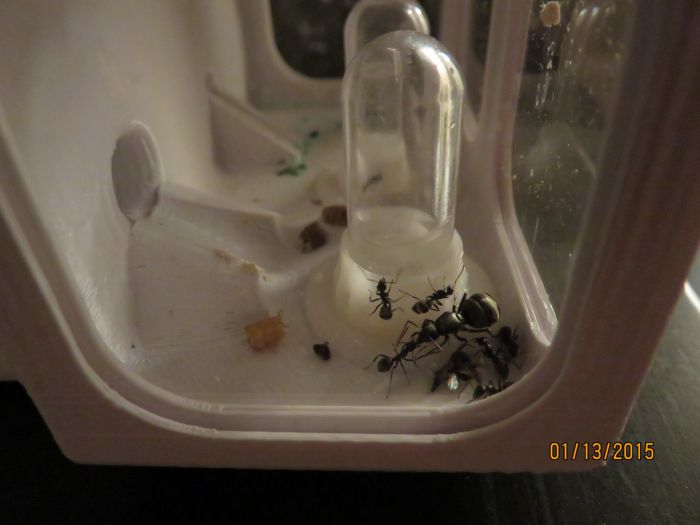

A worker died but I knew she was going to die. She had been acting slowly and weirdly for past 2 days.
Edited by dean_k, January 13 2015 - 6:03 PM.
Part 2 of Jan 13 update.
I had to add this. Since the queen and her workers moved to the new liquid feeder, I was going to take the old feeder out. Then I saw the queen had something in her mouth. I wasn't 100% sure but I thought she had something in her mouth.
So, I quickly booted up my laptop and turned my microscope on. I wasn't sure what it was for a while and she sticks it onto the old feeder @ 2:53, great...
I took the old feeder out anyway and picked it up with a forceps. It turned out to be maggot gut, so I put it back next to the queen.
Edited by dean_k, January 13 2015 - 8:19 PM.
After receiving a revised Grotube from drtrmiller (I had to drive back to work to pick it up because it came after I left work), I replaced the old Grotube with new one and it happened... brutally fast.
This was what I did.
1. Open the outworld. The ants freaked out. But they were going to have it worse.
2. I removed the liquid feeder. It was dried at this point anyway and, following Crystal's advice, I blew my breath.
3. They totally freaked out and ran in all directions except the queen.
4. A worker ran into the new Grotube and stayed in there unlike last time a worker entered and left the old Grotube.
5. Another worker entered and remained in there for exactly 60 seconds or so.
And then it happened, the nest relocation dragging. The two ants came out and started to drag everyone into the new nest. And even before I could turn my laptop on and record, all ants, including the queen, was dragged into the new Grotube.
I could only take a video of the last worker being dragged. It happened that fast. Within a minute or so, everyone was in the nest. This leads me to the assumption I made earlier. The old Grotube wasn't spacious enough for them.
A very short video of the last working being dragged. (Only from 0:01 to 0:05)
And after they quickly settled down in the new Grotube.
As far as I can see, two workers are being foragers and rest are staying put with the queen.
Edited by dean_k, January 15 2015 - 8:14 PM.
Below is a photo of old Grotube I took after I took it out. You can see that workers indeed explored the area and used it as outworld. You can see they took out trash (Fruit fly wings) into there.
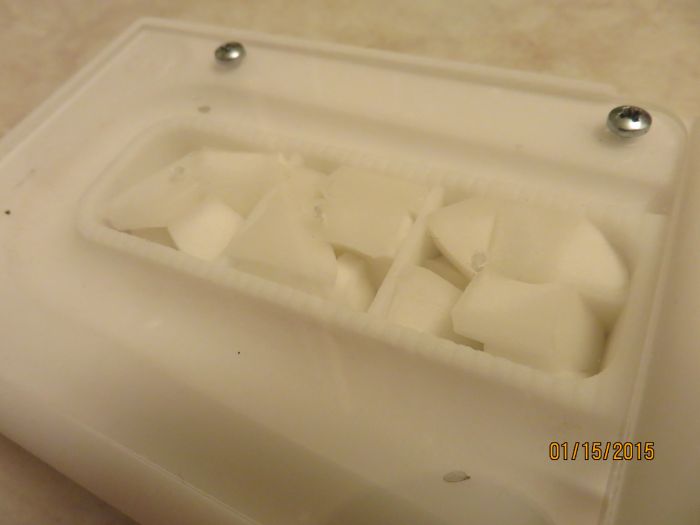
I also kept the substrate from my previous order and used the coconut fiber in the outworld. (After I cleaned the outworld. It was a mess.)
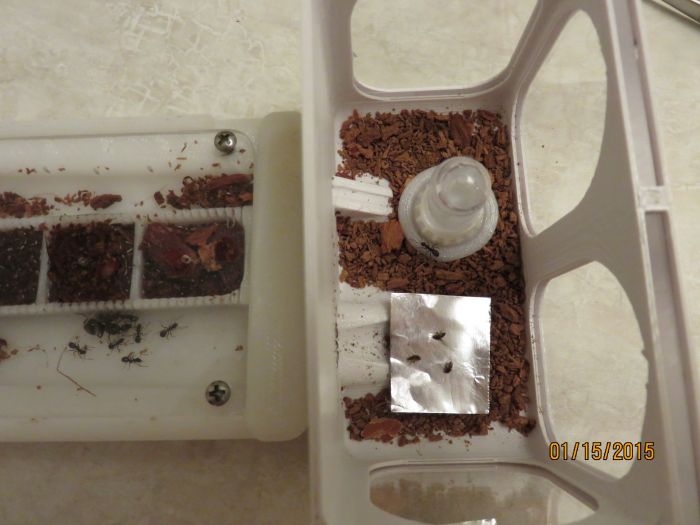

And I've decided to test a new liquid feeder he sent in my Mymrica colony because they are a lot more active and seek more fluid. The Myrmica colony has also recently showed some interest in Blue 100 again, I've been giving them it. I have yet to see their old behavior of taking it back into the nest however.
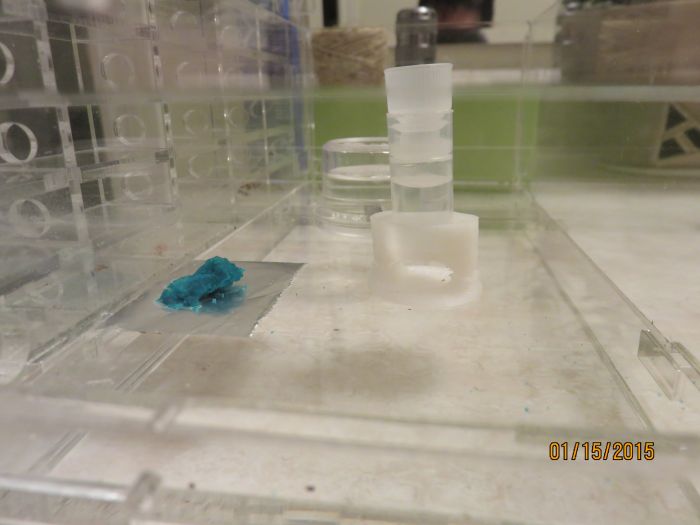
Edited by dean_k, January 15 2015 - 8:46 PM.
0 members, 0 guests, 0 anonymous users